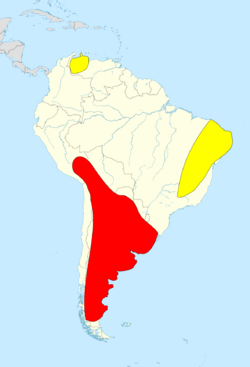Biology:Xenorhinotherium
| Xenorhinotherium | |
|---|---|

| |
| Mounted skeleton of X. bahiense | |
| Scientific classification | |
| Domain: | Eukaryota |
| Kingdom: | Animalia |
| Phylum: | Chordata |
| Class: | Mammalia |
| Order: | †Litopterna |
| Family: | †Macraucheniidae |
| Subfamily: | †Macraucheniinae |
| Genus: | †Xenorhinotherium Cartelle & Lessa, 1988 |
| Species: | †X. bahiense
|
| Binomial name | |
| †Xenorhinotherium bahiense Cartelle & Lessa, 1988
| |

| |
| Map showing the distribution of Macrauchenia in red, and Xenorhinotherium in yellow, inferred from fossil finds | |
Xenorhinotherium is an extinct genus of macraucheniine macraucheniids, closely related to Macrauchenia of Patagonia. The type species is X. bahiense.[1]
Taxonomy
Some authors consider the genus Xenorhinotherium a synonym of Macrauchenia, while all others consider it a distinct genus.[2] The name Xenorhinotherium means "Strange-Nosed Beast" and bahiense refers to the Brazilian state of Bahia, where the first fossils were found.[3]
Xenorhinotherium was a rather derived representative of the Macraucheniidae, a group of litopterns with camel-like appearances. Probably derived from lower Miocene forms such as Cramauchenia and Theosodon, this animal probably closely related to the large macraucheniids of the Pliocene and Pleistocene, such as Macrauchenia and Windhausenia.[4][5]
Below is a phylogenetic tree of the Macraucheniidae, based on the work of McGrath et al. 2018, showing the position of Xenorhinotherium.[4]
| |||||||||||||||||||||||||||||||||||||||||||||||||||||||||||||||||||||||||||||||||||||||||||||||||||||||||||||||||||||||||||||||
Characteristics
X. bahiense was a megafaunal herbivore that probably looked very much like Macrauchenia, weighing about 940 kg (2,070 lb).[6] In life, X. bahiense would have vaguely resembled a tall, humpless camel with three toes on each foot and either a saiga-like proboscis[7] or a moose-like nose.[8] Pictographs from the Serranía de La Lindosa rock formation of Guaviare, Colombia, show what might possibly be Xenorhinotherium with three toes and a trunk, though the claims are highly controversial, and it is uncertain whether they even date to the last Ice Age.[9][10]
Distribution
Fossils of Xenorhinotherium, dating from the Late Pleistocene to the Early Holocene, have been found in the states of Bahia, the Jandaíra Formation of Rio Grande do Norte,[1] and Minas Gerais in modern Brazil,[11] and also in Venezuela, in the localities of Muaco, Taima-Taima and Cuenca del Lago.[12][13]
Though not known from other countries, computer modelling suggests that the habitat in the western Andean slopes of Colombia, Ecuador, and Peru would have been suitable for this animal, particularly in areas that have not been extensively excavated yet.[2]
References
- ↑ 1.0 1.1 Xenorhinotherium at Fossilworks.org
- ↑ 2.0 2.1 de Oliveira, Karoliny; Araújo, Thaísa; Rotti, Alline; Mothé, Dimila; Rivals, Florent; Avilla, Leonardo S. (2020-03-01). "Fantastic beasts and what they ate: Revealing feeding habits and ecological niche of late Quaternary Macraucheniidae from South America" (in en). Quaternary Science Reviews 231: 106178. doi:10.1016/j.quascirev.2020.106178. ISSN 0277-3791. Bibcode: 2020QSRv..23106178D. https://www.sciencedirect.com/science/article/pii/S0277379119305177.
- ↑ Cartelle, C.; Lessa, G. (1988). "Descrição de um novo gênero e espécie de Macrauchenidae (Mammalia, Litopterna) do Pleistoceno do Brasil" (in Portuguese). Paulacoutiana 3: 3–26.
- ↑ 4.0 4.1 Andrew J. McGrath; Federico Anaya; Darin A. Croft (2018). "Two new macraucheniids (Mammalia: Litopterna) from the late middle Miocene (Laventan South American Land Mammal Age) of Quebrada Honda, Bolivia". Journal of Vertebrate Paleontology 38 (3): e1461632. doi:10.1080/02724634.2018.1461632. Bibcode: 2018JVPal..38E1632M. https://figshare.com/articles/dataset/Two_new_macraucheniids_Mammalia_Litopterna_from_the_late_middle_Miocene_Laventan_South_American_Land_Mammal_Age_of_Quebrada_Honda_Bolivia/6392447.
- ↑ Schmidt, Gabriela I.; Ferrero, Brenda S. (September 2014). "Taxonomic Reinterpretation of Theosodon hystatus Cabrera and Kraglievich, 1931 (Litopterna, Macraucheniidae) and Phylogenetic Relationships of the Family". Journal of Vertebrate Paleontology 34 (5): 1231–1238. doi:10.1080/02724634.2014.837393. Bibcode: 2014JVPal..34.1231S.
- ↑ "Xenorhinotherium bahiense". https://www.theextinctions.com/xenorhinotherium-bahiense.
- ↑ The illustrated encyclopedia of dinosaurs and prehistoric animals. Palmer, Douglas., Cox, C. Barry (Christopher Barry), 1931-. London: Marshall Pub. 1999. ISBN 1-84028-152-9. OCLC 44131898. https://www.worldcat.org/oclc/44131898.
- ↑ Moyano, Silvana Rocio; Giannini, Norberto Pedro (November 2018). "Cranial characters associated with the proboscis postnatal-development in Tapirus (Perissodactyla: Tapiridae) and comparisons with other extant and fossil hoofed mammals". Zoologischer Anzeiger 277: 143–147. doi:10.1016/j.jcz.2018.08.005.
- ↑ Morcote-Ríos, Gaspar; Aceituno, Francisco Javier; Iriarte, José; Robinson, Mark; Chaparro-Cárdenas, Jeison L. (29 April 2020). "Colonisation and early peopling of the Colombian Amazon during the Late Pleistocene and the Early Holocene: New evidence from La Serranía La Lindosa". Quaternary International 578: 5–19. doi:10.1016/j.quaint.2020.04.026.
- ↑ "12,000-Year-Old Rock Drawings of Ice Age Megafauna Discovered in Colombian Amazon | Archaeology | Sci-News.com" (in en-US). http://www.sci-news.com/archaeology/ice-age-megafauna-rock-drawings-colombian-amazon-09117.html.
- ↑ Scherer, Carolina; Pitana, Vanessa; Ribeiro, Ana Maria (28 December 2009). "Proterotheriidae and Macraucheniidae (Litopterna, Mammalia) from the Pleistocene of Rio Grande do Sul State, Brazil". Revista Brasileira de Paleontologia 12 (3): 231–246. doi:10.4072/RBP.2009.3.06.
- ↑ Socorro 2006, p. [page needed].
- ↑ Morón 2015, p. 110.
Bibliography
- Morón, Camilo (January 2015). "Panorama geológico, paleontológico, arqueológico, histórico y mitológico del estado Falcón" (in Spanish). Boletín Antropológico 89 (1). http://www.saber.ula.ve/handle/123456789/40734.
- Socorro, Orangel Antonio Aguilera (2006) (in Spanish). Tesoros paleontológicos de Venezuela: el cuaternario del Estado Falcón. Ministerio de la Cultura. ISBN 978-980-12-1379-6.
Further reading
- Nascimento, Karoliny de Oliveira (27 February 2019). Paleoecologia alimentar de macrauchenia patachonica e xenorhinotherium bahiense (macraucheniidae: litopterna: mammalia) e o reconhecimento de seus nichos ecológicos [Food paleoecology of macrauchenia patachonica and xenorhinotherium bahiense (macraucheniidae: litopterna: mammalia) and the recognition of their ecological niches] (Thesis) (in Portuguese).CS1 maint: unrecognized language (link)
- McGrath, Andrew J.; Anaya, Federico; Croft, Darin A. (4 May 2018). "Two new macraucheniids (Mammalia: Litopterna) from the late middle Miocene (Laventan South American Land Mammal Age) of Quebrada Honda, Bolivia". Journal of Vertebrate Paleontology 38 (3): e1461632. doi:10.1080/02724634.2018.1461632. Bibcode: 2018JVPal..38E1632M. https://figshare.com/articles/dataset/Two_new_macraucheniids_Mammalia_Litopterna_from_the_late_middle_Miocene_Laventan_South_American_Land_Mammal_Age_of_Quebrada_Honda_Bolivia/6392447.
- de Oliveira, Karoliny; Araújo, Thaísa; Rotti, Alline; Mothé, Dimila; Rivals, Florent; Avilla, Leonardo S. (March 2020). "Fantastic beasts and what they ate: Revealing feeding habits and ecological niche of late Quaternary Macraucheniidae from South America". Quaternary Science Reviews 231: 106178. doi:10.1016/j.quascirev.2020.106178. Bibcode: 2020QSRv..23106178D.
Wikidata ☰ Q20719561 entry
 |


